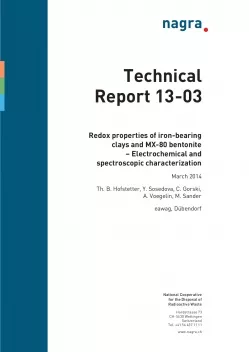
Technical Report NTB 13-03
Redox properties of iron-bearing clays and MX-80 bentonite – Electrochemical and spectroscopic characterization
The characterization of the redox properties of Fe-bearing minerals in the presence and absence of dissolved Fe2+ is of major relevance for the assessment of redox reactions in natural and engineered environments such as radioactive waste repositories. In this study, we developed an electrochemical approach based on the use of soluble organic electron transfer mediators, which enabled us to quantify the redox properties of Fe-bearing clay minerals, MX-80 bentonite and combinations of clay minerals, Fe oxides and dissolved Fe2+. Using mediated electrochemical oxidation and reduction, we quantified the electron accepting and donating capacities of ferruginous smectite SWa-1, Wyoming montmorillonite SWy-2 and MX-80 bentonite at pH 7.5. All structural Fe in clay minerals was redox-active in contrast to that present in other, not further defined phases of MX-80. The materials investigated were redox-active over a very wide range of Eh-values, that is the Fe2+/Fetotal ratio of the minerals changed from 0 to 100 % between +600 and -600 mV (vs. SHE). Redox properties were highly path-dependent due to structural changes of the minerals as revealed from the study of native and redox-cycled clay minerals after repeated reduction and re-oxidation cycles. Irreversible alteration of the mineral structure, however, was less obvious for materials with lower total Fe content such as MX-80 bentonite and SWy-2. Systems containing native montmorillonites (SWy-2 or MX-80), goethite and dissolved Fe2+ were also able to buffer the reduction potential EH between 0 and -300 mV. Regardless of their Fe oxidation state, Fe-bearing minerals are redox-active over a wide potential range and therefore very relevant as redox buffers determining the fate of redox-active radionuclides and metals in waste repositories.
